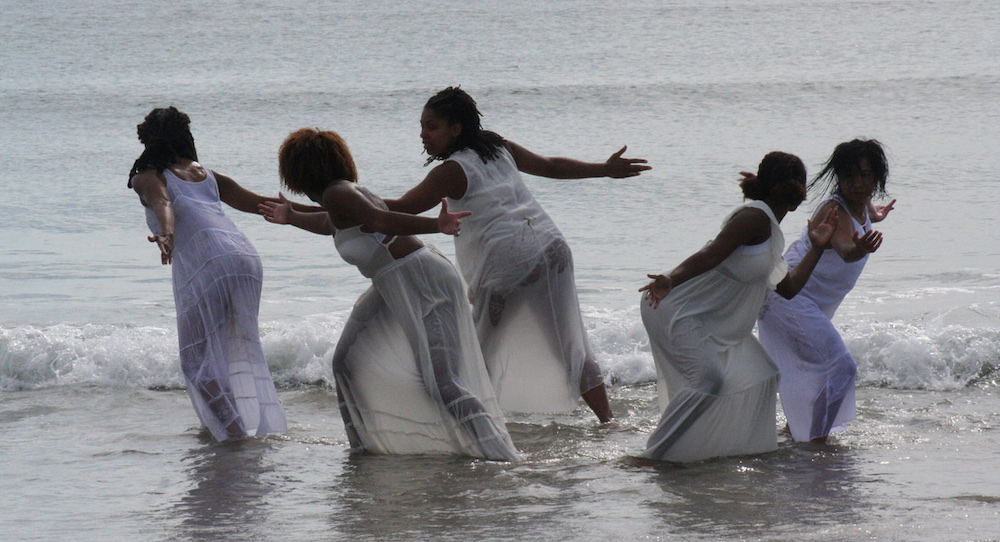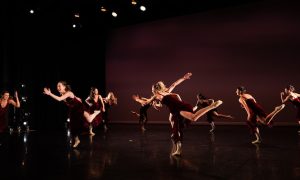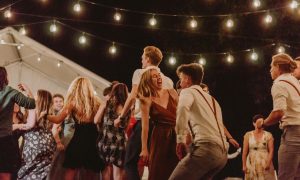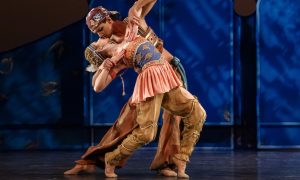Harvard Smith Center, Cambridge, MA, and via livestream.
October 21, 2021.
Wind rustling through leaves, the smell of saltwater at the seashore, the crunch of pebbles under feet — places we inhabit come to have their own sensory and energetic signatures. Particularly in cases of trauma and oppression, places can also have an emotional weight that’s palpable to those who are in a position to feel that weight.
This sort of energetic connection of people and the places that are part of their history was central to Initiation — In Love Solidarity, created by Nailah Randall-Bellinger and commissioned by the Harvard University Committee on the Arts. Randall-Bellinger was one of seven artists commissioned by the committee in 2021, and is also currently an artist-in-residence at Harvard Dance Center.
Through contemporary and African Diasporic-inspired movement and strong supporting design elements, the work abstractly explored the Middle Passage of the Transatlantic Slave Trade. Thoughtful movement, structure, and shaping of concept made it a work not to miss and one not easily forgotten. Learning that the work was filmed on location at sites with histories connected with the transatlantic slave trade, as program information shared, made it all the more impactful.
The film opened with a woman dressed in white dancing in an open field, with the partner of a classic wooden cabin. “I too sing America,” proudly declared a narrator. She shared evocative images, both tangible (cowrie shells) and more abstract (the African diaspora, repetitive resilience and the chorus of humanity) — and also ethereal (“seawater spirit”).
Throughout that voiceover, a woman danced in front of a wood cabin — grounded, expansive yet also with a sense of inner connection. Then the camera shifted to an expansive field, and more dancers in white moved on, over, around wood benches (cinematography by Christina Belinsky). They shaped, carved and formed negative space. They opened and closed their torsos as their spines rippled through arch/contract — smooth yet clear like waves.
The next scene opened on the dancers at the meeting of the ocean and the land: resting in sand, waves washing over them in steady rhythm. Were the waves gentle nourishment, or laden with threat and difficult weight? Reasonable people could interpret this creative choice either way. The energy rose higher soon, in both music and movement — those elements in alignment.
To the former, jazz inflections peppered and shaped the score (“Harmony with Nature” by Matthew Halsall) — instilling a sense of the deep history of the African Diaspora and all of the creative wonder that it generated, the beauty that grew from pain and trauma. Evincing the resilience and connection that hums on despite that trauma, the dancers reached up to the sun and to one another. They moved with a grounded and reflective quality, yet also at points with a sense of play as they ran in the waves.
Further building that sense of playfulness, they high-fived hands in a train (passing on to the next dancer the high-five they received). There was also deep tenderness at other moments, physically-expressed: a hand to a shoulder, a head resting on a neck, a quick embrace and release to propel further movement. The dancers also seemed to savor the power and beauty of their body, moving their hips with space and size and fearlessly expanding their limbs out in the open space.
In memorable movement vocabulary, they reached their arms up with one leg in attitude and then released both the lifted leg and their torsos down, embodying connection to both earth and sky. They filled their movement with breath, the inhales creating form and the exhales offering release.
Illustrating mutual protection and support, they formed a circle and stood back to back — gazes assured and distant over the waves. In appealing contrast, moments of one-on-one connection juxtaposed that group unity — and also offered opportunities for fresh movement vocabulary. Simultaneously, another dancer moved and took up space along the endless horizon line: perhaps a witness, perhaps a protector, perhaps one waiting for a similar connection with another.
Soon, the group moved to a beachside building, smiling to one another while running and dancing up the wooden ramps and steps outside the home. They lifted their skirt in a playful way, embracing femininity but also displaying the fierceness in their feminine power.
Coming full circle, the next scene brought the group to the lawn in front of that wooden cabin. They danced with contemporary and African dance-inspired vocabulary, grounding deep but expanding limbs wide. Although much of the movement was unison, the dancers’ unique bodies and spirits shined through that unison.
They continued taking up all of the space available to them, their bodies graceful but unapologetic. The group dancing here, with both rock-solid technique and 150 percent commitment to their performance, made this section differ — no greater or lesser — than the opening scene of one person moving there.
In solitude, there is quiet and connection to oneself, and in community, there is action and connection to others. The places through which we experience both also have much to teach us — as do the bodies in which we move through them.
It sometimes just takes listening closely enough that we can hear the leaves rustle and the waves crash — to feel the spirits of places, whatever they may have to share with us: joyful, somber or painful. Deep gratitude to Randall-Bellinger and collaborators for reminding us of these important truths with the layered and resonant In Love, Solidarity.
By Kathryn Boland of Dance Informa.















